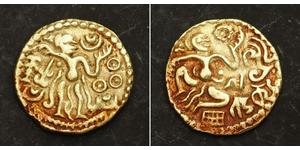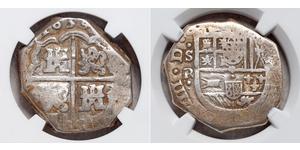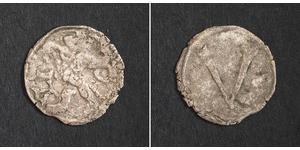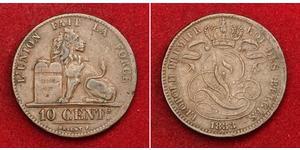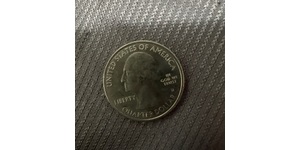(Vendida por $120.0)
1509, India, Vijayanagar Empire, Krishnadevaraya. Gold ½ Pagoda Coin. 1.49gm!
Country: India Culture: Vijayanagar Empire Mint Period: 1509-1529 AD Denomination: Gold ½ Pagoda Ruler: Vijayanagar Empire, Krishnadevaraya (1509-1529) Reference: Friedberg 357, Vijayanagar 9.3.5, Mitchiner 899. R! Condition: Tooling (removed suspension loop) at 12 o'clock, weakly struck reverse, otherwise VF+ Diameter: 12mm Weight: 1.49gm Material: Gold!
Obverse: Balakrishna seated facing. Chakra to left, śankha to right.
Reverse: Inscription in three lines. Legend: "śri pra - tapa krishna - raya"
Vishnu (विष्णु) is a Hindu god, the Supreme God of Vaishnavism (one of the three principal denominations of Hinduism) and one of the three supreme deities (Trimurti) of Hinduism. He is also known as Narayana and Hari. As one of the five primary forms of God in the Smarta tradition, he is conceived as "the Preserver or the Protector" within the Trimurti, the Hindu Trinity of the divinity. In Hindu sacred texts, Vishnu is usually described as having dark complexion of water-filled clouds and as having four arms. He is depicted as a blue being, holding a padma (lotus flower) in the lower left hand, the Kaumodaki gada (mace) in the lower right hand, the Panchajanya shankha (conch) in the upper left hand and the discus weapon Sudarshana Chakra in the upper right hand.
Lakshmi is the Hindu goddess of wealth, love, prosperity (both material and spiritual), fortune, and the embodiment of beauty. She is the wife and active energy of Vishnu. Her four hands represent the four goals of human life considered proper in Hindu way of life – dharma, kama, artha, and moksha. Representations of Lakshmi are also found in Jain monuments. In Buddhist sects of Tibet, Nepal and southeast Asia, goddess Vasudhara mirrors the characteristics and attributes of Hindu goddess Lakshmi, with minor iconographic differences. Lakshmi is also called Sri or Thirumagal because she is endowed with six auspicious and divine qualities, or Gunas, and also because she is the source of strength even to Vishnu. When Vishnu incarnated on the Earth as the avatars Rama and Krishna, Lakshmi took incarnation as his consort. Sita (Rama's wife), Radha (Krishna's lover), Rukmini and Satyabama are considered forms of Lakshmi. In ancient scriptures of India, all women are declared to be embodiments of Lakshmi. The marriage and relationship between Lakshmi and Vishnu as wife and husband, states Patricia Monaghan, is "the paradigm for rituals and ceremonies for the bride and groom in Hindu weddings". Archeological discoveries and ancient coins suggest the recognition and reverence for goddess Lakshmi, in Scytho-Parthian kingdom and throughout India, by 1st millennium BC. Lakshmi's iconography and statues have also been found in Hindu temples of southeast Asia, estimated to be from second half of 1st millennium AD. In modern times, Lakshmi is worshipped as the goddess of wealth. She is also worshipped as the consort of Vishnu in many temples. The festivals of Diwali and Sharad Purnima (Kojagiri Purnima) are celebrated in her honour.
The Vijayanagara Empire referred to as the Kingdom of Bisnagar by the Portuguese, was an empire based in South India, in the Deccan Plateau region. It was established in 1336 by Harihara I and his brother Bukka Raya I. The empire rose to prominence as a culmination of attempts by the southern powers to ward off Islamic invasions by the end of the 13th century. It lasted until 1646 although its power declined after a major military defeat in 1565 by the Deccan sultanates. The empire is named after its capital city of Vijayanagara, whose ruins surround present day Hampi, now a World Heritage Site in Karnataka, India. The writings of medieval European travelers such as Domingo Paes, Fernão Nunes and Niccolò Da Conti, and the literature in local languages provide crucial information about its history. Archaeological excavations at Vijayanagara have revealed the empire's power and wealth.
The empire's legacy includes many monuments spread over South India, the best known of which is the group at Hampi. The previous temple building traditions in South India came together in the Vijayanagara Architecture style. The mingling of all faiths and vernaculars inspired architectural innovation of Hindu temple construction, first in the Deccan and later in the Dravidian idioms using the local granite. Secular royal structures show the influence of the Northern Deccan Sultanate architecture. Efficient administration and vigorous overseas trade brought new technologies such as water management systems for irrigation. The empire's patronage enabled fine arts and literature to reach new heights in the languages of Kannada, Telugu, Tamil and Sanskrit, while Carnatic music evolved into its current form. The Vijayanagara Empire created an epoch in South Indian history that transcended regionalism by promoting Hinduism as a unifying factor.
Sri Krishna Deva Raya also known as Krishna Rai in some inscriptions was the famed Emperor of the Vijayanagara Empire who reigned from 1509 - 1529 CE. Presiding over the empire at its zenith, he is regarded as an icon by many Indians. Emperor Krishna Deva Raya earned the titles Kannada Rajya Rama Ramana, Mooru Rayara Ganda (meaning King of three kings) and Andhra Bhoja. He was one of the greatest statesmen which medieval South India had produced. Much information about his reign comes from the accounts of Portuguese travelers Domingo Paes and Fernao Nuniz. Krishna Deva Raya benefited from the able prime minister Timmarusu, who was regarded by the king as a father figure and was responsible for his coronation. Krishna Deva Raya was the son of Nagala Devi and Tuluva Narasa Nayaka, an army commander under Saluva Narasimha Deva Raya, who later took control of the empire to prevent its disintegration and became the founder of the Tuluva Dynasty, the third Hindu Dynasty to rule Vijayanagara. The king's coronation took place on the birthday of Hindu God Krishna, and his earliest inscription is from July 26, 1509 CE. He built a beautiful suburb near Vijayanagara called Nagalapura in memory of his mother, Nagala.

1 Tetradracma Antigua Grecia (1100BC-330 ...
grupo tiene 31 monedas / 31 precios
Add coin to this group
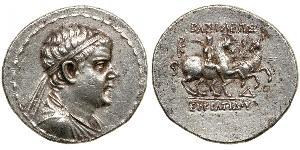
1 Tetradracma Antigua Grecia (1100BC-330 ...
grupo tiene 4 monedas / 2 precios
Add coin to this group
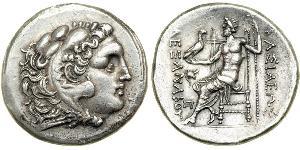
Tetradracma Reino de Macedonia (800BC-1 ...
grupo tiene 202 monedas / 195 precios
Add coin to this group
10 Centime Bélgica Cobre Leopoldo I de Bélgica (1790-1865)
grupo tiene 8 monedas / 8 precios
⇑
536 coins were uploaded from 2025-06-11 to 2025-06-18
Una de ellas es:










